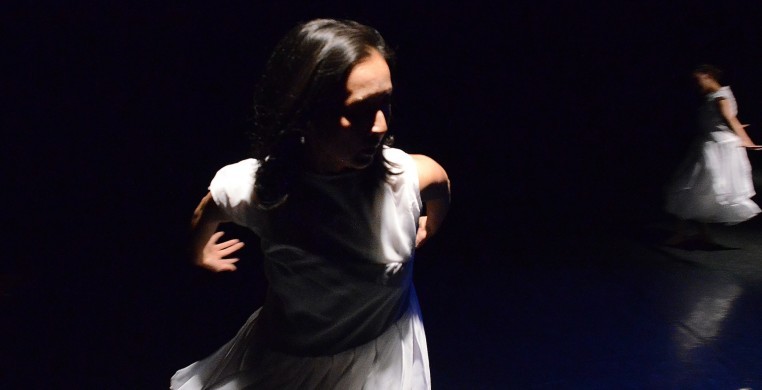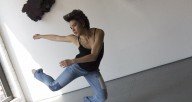UPDATE: The new seechicagodance.com will launch March 31st. Click here to learn more.
Preview: Dance A Moving Canvas, Final Installment
By Sid Smith
The final installment of the Moving Canvas series will involve work embracing one of the most profound aspects of art--its literal reach to infinity.
The idea is rooted in all craft and all philosophy, the notion of an invisible extension tying limited physical matter to an immeasurable universe, a kind of metaphysical manifestation of what we call truth. One common example comes from mathematics, wherein such seemingly simple concepts as a physical line or a scale of numbers bring home the point. Mathematicians talk of a line as an idea and of how, when you draw it on a page, it actually extends in either direction without end. So do numbers going up and down, starting from zero and moving in both directions. There is no finite end, at least in the mental arena of the imagination.
This construct informs the work of both choreographer Ayako Kato and curator Erin Toale, whose efforts will be witnessed side by side at Wednesday's Moving Canvas event at the Chicago Artists Coalition, 217 N. Carpenter St. As in past instances, Toale's exhibit, dubbed "Radical Natural," features work by three artists in place and on exhibit at the space during Kato's performance. But in this case the two leaders share a vision regarding the extensive, extending possibilities of artistic work, invisible lines that head out and away from the physical manifestations of the works themselves into a larger environment.
"In my work, I focus on anatomical exercise, almost like making ourselves tune into a formal structure in our bodies, into its muscle fiber," Kato said. "You can kind of imagine the details of the structure of your body from top to bottom, and when we start movement, that movement always happens through this structure and beyond the structure as an extension of the structure."
What Kato is describing is anything but simplistic: Her art is influenced by Taoism, Buddhism and Japanese tradition. In performance, with multiple dancers, involving something as simple as an overall figure 8 design, she notes that in her work, "We move through space with others, and know to avoid bumping into each other as well as going around forms or objects. We need to be tuning into one another. Usually, dance steps are a matter of a certain count. But this is about reading other people's energy. You can't just be focused on yourself. You have to holistically tune into everything." Those invisible lines are an aspect of the interconnectedness of everything.
In discussing the three artists (Liz Gadelha, Wolfie E. Rawk and Nora Renick-Rinehart) in "Radical Natural," curator Toale also talks of extension, in particular "the unique relationship each artist has with nature." These are works that speak to a world beyond any exhibition walls. Toale titled the show with this in mind. "This relationship is explicit in Nora and Liz's practice, which takes place out of doors, and much more subtle and language-based in Wolfie's work."
And in what promises to deepen this concept, Kato plans to interact with elements in the exhibit. The relationship of dance and art will be dynamic. Garments, for instance, that are part of artist Gadelha's contribution will be worn by the dancers.
"This is the first time that Liz is showing the garments that she and her mother hand-sewed alongside the resulting photographs of the pair performing in them," Toale said. "The garments invite interaction and movement, which is why I think that it's so great that Ayako and the other dancers will be wearing them. In a similar way, all of the works in the exhibit invite activation and human interaction. Wolfie's work is immersive, you have to enter it and utilize all of your sense to experience it. Nora's wall paintings are seductive, people can't resist photographing themselves in front of them."
The underlying notion behind Moving Canvas is interdisciplinary, linking dance and visual art. This time, the practitioners from the two disciplines move outside boundaries almost as a starting point, like some sort of undulating, spreading natural force.
As inspiration Kato cites the so-called butterfly effect, a concept in chaos theory involving physical interdependency, named for the idea that a hurricane formation is somehow dependent on the fluttering of a butterfly weeks earlier.
"Ayako described it to me as a ripple effect," Toale said. "The works in Radical Natural provoke questions of contemporary selfhood in relation to urban versus rural environments. Some...are about isolation, some relate to oneness with. All of the works, and Ayako's choreography, speak, to some level of interaction with nature and the degree of chance that relationship introduces."
"Even though something looks random to human beings, in nature there are principles," Kato put it. "Except that human beings maybe don't understand them. But everything in nature is happening as it has to be. Yes, we have a will, but your will is a part of nature, nature may intervene with it and we have to cope with that."
Therein lies the meaning and method of her art: "I want to find the absolute moment of being, which is happening all the time, and convey that moment through minimal expression."


